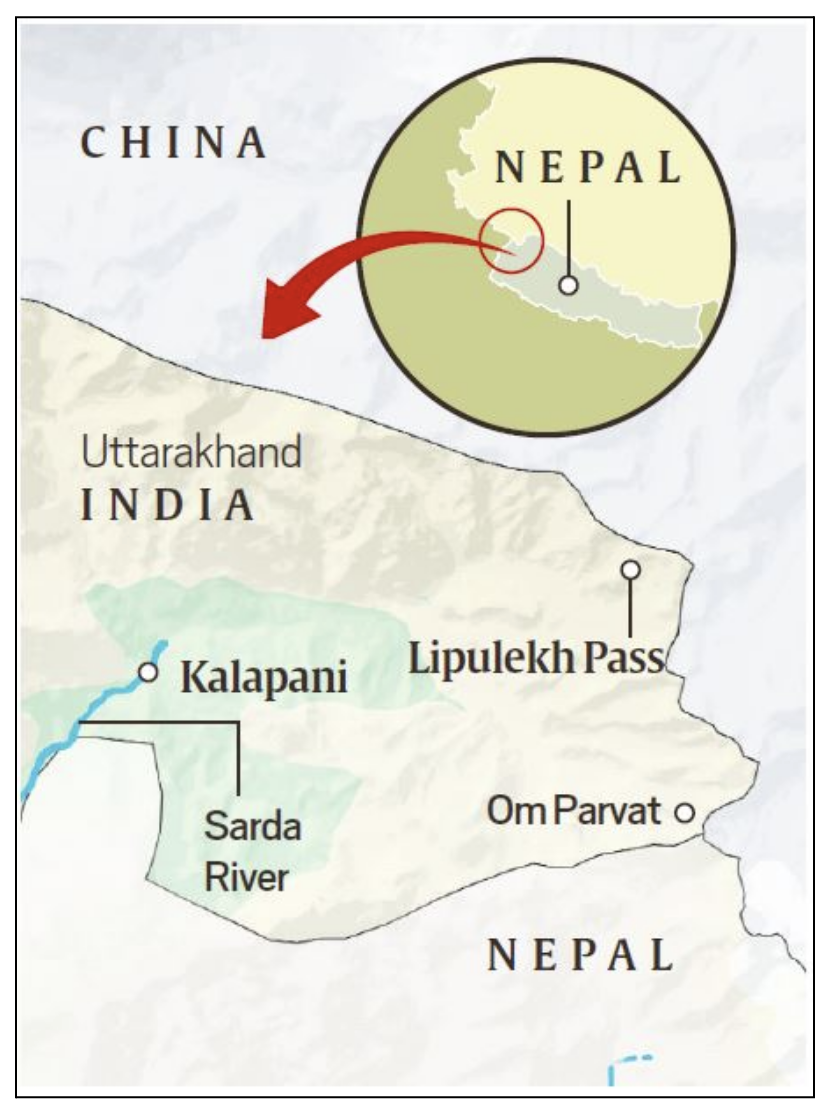GS Paper II
News Excerpt:
India has strongly reacted to the Nepal Government's decision of a map depicting areas in India as part of its territory on a new currency note.
The disputed territory:
- The territorial dispute is about a 372-sq-km area that includes Limpiadhura, Lipulekh, and Kalapani at the India-Nepal-China trijunction in Uttarakhand’s Pithoragarh district.
- Nepal has claimed for long that these areas belong to it both historically and evidently.

Background of the current issue:
- The disputed map claiming Indian territories as Nepalese was adopted by consensus in Nepal’s Parliament four years ago in 2020.
- Later the Prime Ministers of India and Nepal agreed to have the boundary issue examined and settled through diplomatic channels.
- But four years after Nepal included the areas of Kalapani, Lipulekh and Limpiyadhura in its new map, the government in Kathmandu has decided to come out with a Rs-100 currency note that depicts the country’s map with the areas under Indian control.
Origin of the dispute:
- The India-Nepal territory dispute has roots in the Sugauli Treaty of 1815, which followed the Anglo-Nepalese War (1814-1816).
- The Treaty of Sugauli resulted in Nepal losing a chunk of territory to the East India Company.
- Article 5 of the treaty took away the jurisdiction of Nepal’s rulers over the land to the east of the Kali River.

|
Timeline of India-Nepal border talks |
|
|
1950s |
|
|
1997-1998 |
|
|
July 2000 |
|
|
2014 |
|
|
2023 |
|
Frictions in bilateral ties between the two neighbours:
- India-Nepal relations turned sour when in 2015 Nepalese Maoist government rejected India’s suggestion to consider the concerns of Terai parties in its new constitution.
- The 134-day blockade of Nepal that began in September 2015 created significant distrust against India.
- India maintained its position that Nepal's failure to draft an inclusive Constitution was responsible for the unrest and blockade on the Nepalese side of the border.
- Because of the blockade nearly all sectors of the Nepalese economy took a severe hit, from tourism to transport to domestic factories to agriculture.
- Following the blockade Nepal quickly moved to sign a trade and transit agreement with China in order to create a fallback source for the supply of essential goods.
- In January 2020, Nepal’s parliament voted to change its map to include Lipulekh, Kalapani, and Limpiyadhura as part of its territory whereas India didn’t agree with this change.
- The move was described by the Ministry of External Affairs as “artificial”, “unilateral” and “unacceptable”. India had also asked Nepal to return to dialogue.
- In May 2020, tensions rose when India opened a new 80 km road in Uttarakhand through the Lipulekh pass, a route for the Kailash Mansarovar pilgrimage.
Impact of current dispute on India-Nepal ties:
- Despite the boundary dispute, both Nepal and India share a unique relationship of friendship and cooperation, characterized by open borders and deep-rooted religious, cultural and people-to-people ties.
- India is also Nepal's largest trading partner and is investing billions of dollars in infrastructure, including hydropower plants.
- But the border dispute threatens to derail the ties between the two countries.
Way Forward:
- India and Nepal must chalk out their borders in a formal and friendly manner, to avoid other disputes such as the one over the Kalapani area.
- Both India and Nepal must invest in negotiating new border management agreements to take into consideration recent events.
- The demands of the times have changed since the time the Kalapani border dispute first emerged.
- India should resolve its border conflict with Nepal through discussion as soon as possible, given that it already has an unresolved border dispute with China in the Ladakh region.


